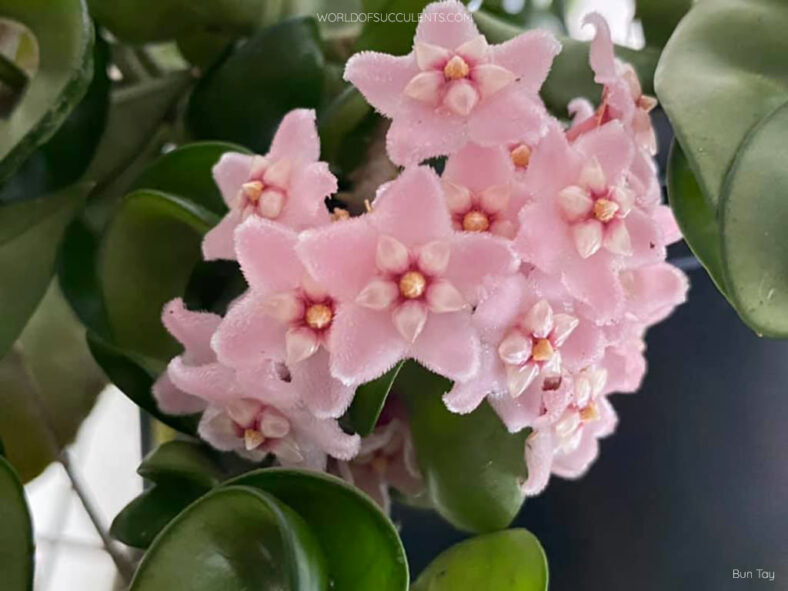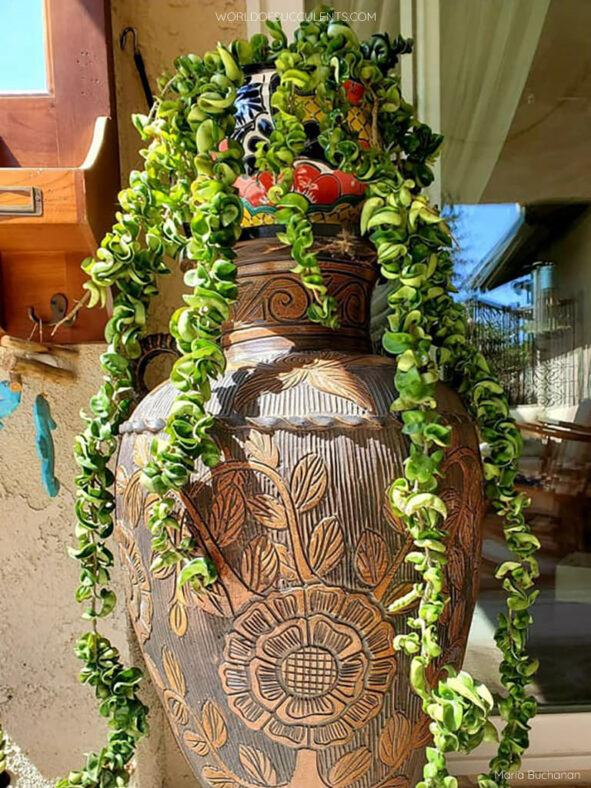Hoya carnosa 'Compacta' is an excellent choice for a houseplant. It has a climbing or trailing growth habit, unique curling leaves, and striking blooms. This plant is easy to care for and grows very slowly, making it a perfect addition to any indoor garden.
Scientific Name
Hoya carnosa 'Compacta'
Accepted Scientific Name
Hoya carnosa (L.f.) R.Br.
Common Name(s)
Angel Rope, Hindu Rope, Hindu Rope Plant, Indian Rope, Krinkle Kurl
Synonym(s)
Hoya carnosa f. compacta, Hoya carnosa 'Krinkle Kurl', Hoya compacta
Scientific Classification
Family: Apocynaceae
Subfamily: Asclepiadoideae
Tribe: Marsdenieae
Genus: Hoya
Etymology
The cultivar epithet "compacta (kom-PAK-tuh)" means "compact" and refers to the closely packed leaves along the stems.
Origin
This plant has never been found in the wild. It was first discovered as a branch mutation sport at Hummel's Exotic Gardens, owned by Edward and Minne Belle Hummel, in Inglewood, California, United States. In 1967, it was popularized under the trademark "Hindu Rope" by B. L. Cobia Nursery Inc. in Winter Garden, Florida, United States.
Description
Hoya carnosa 'Compacta', also known as Hoya compacta or Hoya carnosa 'Krinkle Kurl', is a semi-succulent plant with contorted leaves closely packed along vining stems, giving them a rope-like appearance. The size and color of the leaves may vary, but they can generally be described as curly Hoya carnosa leaves. They are mid-dark green above and dull light green below, measuring up to 2.4 inches (6 cm) in length and 1.2 inches (3 cm) in width.
Typically, in the summer, Hoya carnosa 'Compacta' produces star-shaped, sweetly fragrant flowers in attractive round clusters of 10 to 30. They mature gradually on the same peduncle over 2 to 3 weeks and can reach a diameter of 0.6 inches (1.5 cm). The corolla of the flowers is densely hairy and pinkish to pink, while the corona is white, tinged with red towards the center.

Forms of Hoya carnosa 'Compacta'
How to Grow and Care for Hoya carnosa 'Compacta'
Light: Although this plant can tolerate lower light levels, it may become weak and leggy if the light is too low, producing fewer leaves and flowers. Therefore, it should be kept indoors in bright, indirect sunlight.
Soil: Well-draining soil that provides excellent aeration and does not hold too much water is most important for growing a healthy plant.
Temperature: Hoya carnosa 'Compacta' thrives in hot and humid climates, so keep it away from drafty windows and doorways during the colder months. It grows best in USDA Plant Hardiness Zones 10a to 11b, with average minimum winter temperatures ranging from 35°F to 50°F (-1.1°C to 10°C).
Watering: As this plant is sensitive to overwatering, soak the soil thoroughly in spring and summer, then allow it to dry out before watering again. Otherwise, you will increase the risk of root rot, and your plant will not be happy. It is relatively dormant during the fall and winter, requiring only moderate watering.
Fertilizing: While Hoya carnosa 'Compacta' is not a particularly heavy feeder, it can benefit from high-potassium fertilizer at half strength every two weeks during the growing season.
Repotting: As an epiphyte, this plant has a shallow root system and does not require a deep container. It also does not require frequent repotting. It prefers to be slightly rootbound, so repot it in spring only if it outgrows its container.
Propagation: Although layering is the easiest method to propagate Hoya carnosa 'Compacta', stem cuttings are the most popular way to do so. Using leaf cuttings can be more challenging, while starting from seeds is the simplest but the most time-consuming method. For best results, take cuttings only when the plant is actively growing and sow the seeds in spring and summer.
Learn more at How to Grow and Care for Hoya.
Toxicity of Hoya carnosa 'Compacta'
Hoya carnosa 'Compacta' is considered non-toxic, making it safe to have around children and pets.
Links
- Back to genus Hoya
- Succupedia: Browse succulents by Scientific Name, Common Name, Genus, Family, USDA Hardiness Zone, Origin, or cacti by Genus
Photo Gallery
Click on a photo to see a larger version.


